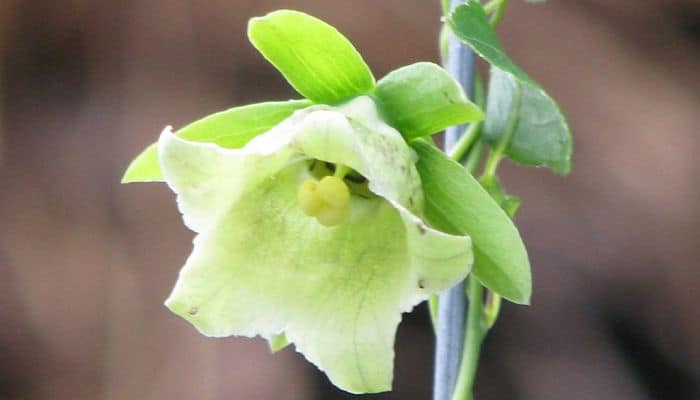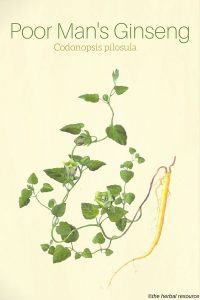Botanical Name: Codonopsis pilosula.
Codonopsis is a genus ( a taxonomic category that ranks above species and below family) that contains about 40 species of herbaceous, perennial plants, all of which are native to central and eastern Asia, some as far south as Malaysia.
More than half of the species have been used in traditional Chinese herbal medicine where Codonopsis pilosula is the most important and widely used.
Other Common Names: Woodland bonnet bellflower, codonopsis, bastard ginseng, false ginseng, cordonklokke (Norwegian), snerleklokke (Danish), fattigmans ginseng (Swedish), dang shen (Chinese).
Habitat: Codonopsis pilosula is native to northeastern China.
Plant Description: Poor man’s ginseng is a fast-growing, perennial vine with oval to heart-shaped, bright green and slightly hairy leaves. It can grow up to two meters tall and the stems contain a milky sap.
The pendulous, bell-shaped flowers are yellow to bright scarlet. They are bisexual and pollinated by insects.
The plant prefers a well-drained, acidic or neutral soil. It should be planted in full sun or partial shade and requires regular moisture during the growing season. The plant is easily propagated by seeds that are sown in the spring. The seeds normally germinate after two weeks.
Plant Parts Used: It is the root of the plant that is used in herbal medicine.
The roots are harvested when the aerial parts of the plant have withered, usually in September or October. The drying is a lengthy process and the way it is done is crucial to the quality of the herb. When the dried roots are black in the middle when cracked, they are considered to be of poor quality.
The dried and chopped roots are roasted in a pan together with millet until they have a yellowish color. Then they are ready to be used, or stored for later use.
Poor man’s ginseng is mostly used in Western herbal medicine in the form of a tincture. In India, the roots of plants belonging to the genus Codonopsis are often ground into an edible flour.

Therapeutic Benefits and Traditional Uses of Dang Shen
Active Ingredient and Substances: Substances found in dang shen include essential oils, polysaccharides, inulin, saponins, scutellarein, resins, mucus, glycosides, alkaloids (choline and perlolyrin), and various amino acids.
Important Herb in Chinese Herbal Medicine
Dang shen, as the dried root of poor man’s ginseng is called in Chinese, is a very important and commonly used herbal medicine in China.
In China, the herb is regarded both as food and medicine. It is often ground into flour, boiled with rice, added to soups and used as an ingredient in nourishing teas.
The roots are viewed as an effective and more affordable substitute for ginseng, hence the common English name “poor man’s ginseng”.
Dang shen is found in many different qualities on the Chinese market. The quality of the herb depends on the plant species used, if it is cultivated or collected from the wild, and the area it comes from.
The main types are western dang shen, eastern dang shen and lu dang shen. These three types are all produced from the species Codonopsis pilosula. Another type, tiao dang shen, originates from Sichuan, a province in southwest China and comes from the plant Codonopsis tangshen. “White dang-shen” is collected from the wild from Codonopsis tubulosa.
Just like ginseng, roots collected from the wild are considered more powerful than those that are cultivated. Wild harvested roots are more expensive, even though they are often smaller.
Roots of high quality have a sweet flavor which is first notice after having chewed on the root for awhile (the roots can easily be eaten raw). Roots of poor quality have very little flavor and are considered to be of less value for medicinal purposes.
Medicinal Uses

Poor man’s ginseng is used traditionally for ailments associated with weakness, fatigue, poor appetite and anemia.
It is also thought to be helpful for diarrhea, vomiting, flatulence and excessive stomach acid.
Laboratory tests suggest that the herb improves digestion by reducing the secretion of pepsin in the stomach and slowing of food as it passes through the stomach on the way to the intestines.
Other ailments that have been treated with dang shen is a headache (when it is due to high blood pressure, muscle tension or indigestion), chronic cough and shortness of breath.
The herb is considered to have blood building properties and to be effective in reducing chronic fatigue syndrome.
The herb is rich in immune enhancing polysaccharides and it is considered to be helpful in building up the immune system in people with cancer who use the herb in conjunction with conventional cancer therapies.
It has also been theorized that the herb may be effective in protecting cancer patients against the adverse effects of radiation therapy without reducing the efficacy of the therapy.
Poor man’s ginseng has also interferon-forming properties, which can be important for people with weakened immune system, including those with HIV infection.
Given the herb’s astringent properties it is also used as a styptic agent in cases of uterine bleeding and excessive menstruation.
In addition, it has also been used as an herbal remedy for arthritis and other conditions of the muscles and joints. The herb has also the reputation as an aphrodisiac.
Pharmacological studies and research have confirmed that dang shen promotes digestion, increases nutrient uptake in the body and enhances the immune system. It also stimulates the nervous system (used in the form of an alcoholic extract), expands the peripheral vascular system and inhibits the activity of the adrenal cortex, which lowers blood pressure.
Studies have also shown that the herb stimulates breathing, increases blood glucose levels and the production of red blood cells. So far scientific studies have not been able to identify one specific chemical substance in the plant that could explain its broad spectrum scope.
Dosage and Administration
The common dosage of poor man’s ginseng is 6-15 g when it is used in conjunction with other herbs in decoction, extracts or powders.
If it is used on its own, the dosage may be as high as 30-60 g daily.
Side Effects and Possible Interactions of Poor Man’s Ginseng (Dang Shen)
Dang shen is considered a safe herb to use.
It is regarded to have very low toxicity and can be used over a long time both as medicine and food.
Supporting References
Balch, Phyllis A.: Prescription for Herbal Healing. New York, Avery 2002.
Bensky, Dan & Andrew Gamble: Chinese Herbal Medicine. Materia Medica. Seattle, Washington, Eastland Press Inc. 1993.
Bown, Deni: The Royal Horticultural Society New Encyclopedia of Herbs & Their Uses. London, Dorling Kindersley 2002.
Molony, David: The American Association of Oriental Medicine’s Complete Guide to Chinese Herbal Medicine. New York, Berkley Books 1998.
Peirce, Andrea: The American Pharmaceutical Association Practical Guide to Natural Healing. New York, William Morrow and Company, Inc. 1999.
Teeguarden, Ron: The Ancient Wisdom of the Chinese Tonic Herbs. New York, Warner Books 1998.
Tierra, Lesley: The Herbs of Life. Freedom, The Crossing Press 1997 (4.print).
Tierra, Michael: The Way of Chinese Herbs. New York, Pocket Books 1998.
Tierra, Michael & Lesley Tierra: Chinese Traditional Herbal Medicine. Vol. 2. Materia Medica and Herbal Resource. Twin Lakes, Lotus Press 1998.
Thordur Sturluson
Latest posts by Thordur Sturluson (see all)
- What is the Difference Between Hemp and Marijuana? - June 3, 2019